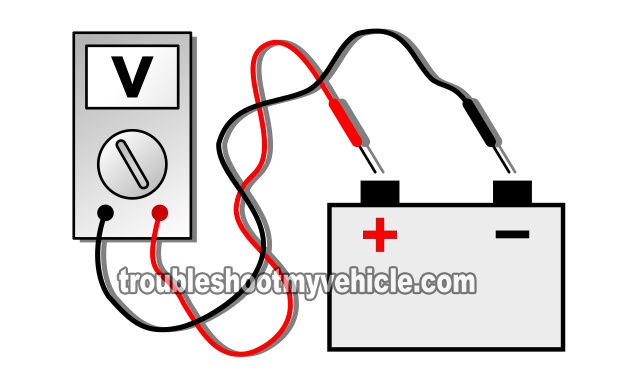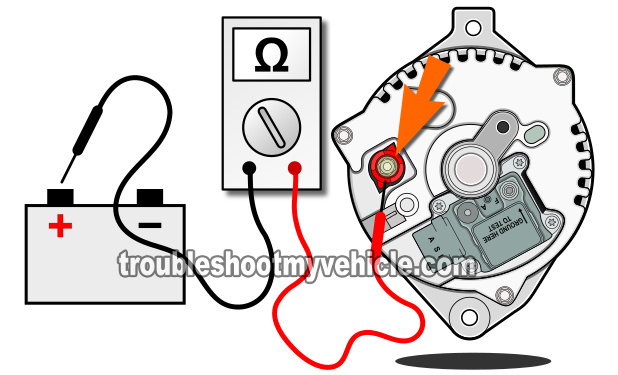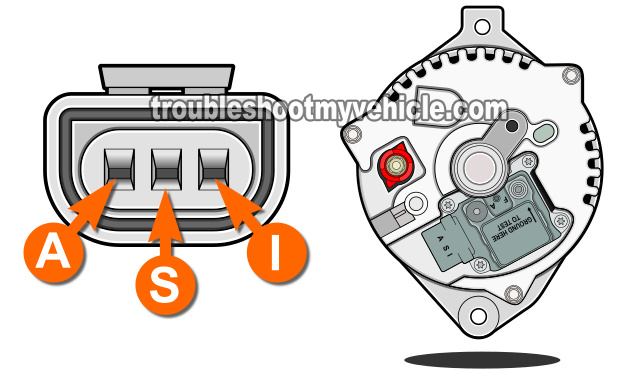
The alternator test, to find out if it's defective or not, on the 1994-1995 3.0L Ford Taurus (Mercury Sable) is not difficult to do. You don't need any fancy or expensive test equipment since you can do the test with a simple multimeter.
And the cool thing is that you can do the test yourself to find out if the alternator is bad or not. All is explained in a step-by-step manner in this tutorial.
Contents of this tutorial:
ES ![]() You can find this tutorial in Spanish here: Cómo Probar El Alternador (1994-1995 3.0L Ford Taurus) (at: autotecnico-online.com).
You can find this tutorial in Spanish here: Cómo Probar El Alternador (1994-1995 3.0L Ford Taurus) (at: autotecnico-online.com).
APPLIES TO: This tutorial applies to the following vehicles:
- 3.0L V6 Ford Taurus: 1994, 1995.
- 3.0L V6 Mercury Sable: 1994, 1995.
Symptoms Of A Bad Alternator
Usually, when the alternator fails in your 1994-1995 3.0L Ford Taurus (or Mercury Sable), you're going to see the battery light shining nice and bright on the instrument cluster.
Unfortunately, this isn't the only symptom that you're going to see. Here's a brief/basic list of symptoms you'll see caused by a defective alternator:
- Charge light is on in the instrument cluster.
- The front headlights shine with a less than normal intensity (when you turn them on).
- The engine doesn't crank over. The only way you can get the engine to crank over is if you jump-start it with another vehicle.
- The engine only cranks and starts if you charge the battery first.
Let's get going with the first test.
Where To Buy The Alternator And Save
The following links will help you to comparison shop for your Ford Taurus' alternator.:
Disclosure: As an Amazon Associate, I earn from qualifying purchases. If my tutorials help you, using these links is an easy way to support the site at no extra cost to you. Thank you!
Not sure if the above alternators fit your particular Ford Taurus? Don't worry, once you get to the site they'll ask you for the specifics of your vehicle and make sure it fits. Doesn't fit they'll find you the right one.
TEST 1: Testing Battery Voltage With The Engine Running

The very first thing I'm going to ask you to do is to check the battery's voltage while the engine is idling.
This voltage test will confirm if the alternator is not charging the battery.
It's important that you perform this test with a multimeter. And what you're looking for is a voltage between 13 and 14.5 Volts DC. If you don't see these 13 to 14.5 Volts DC, while the engine is running, then you can conclude that the alternator is not charging the battery.
If you don't have a multimeter or need to upgrade yours, take a look at this one. It's the one I've been using for years and the one I recommend: Tekpower TP8268 AC/DC Auto/Manual Range Digital Multimeter (Amazon affiliate link).
Alright, these are the test steps:
- 1
Crank and start your 3.0L Ford Taurus and select Volts DC mode on your multimeter.
- 2
Probe the positive battery terminal with the red multimeter test lead.
With the black multimeter test lead, probe the negative battery terminal on the battery on your Ford Taurus. - 3
Your multimeter is gonna' register one of two possible readings and they are:
1.) A steady 13.0 to 14.5 Volts DC.
2.) Or 12.5 Volts that will decrease the longer the engine stays running. - 4
Put an electrical load on the alternator to further confirm that it's either charging or not charging.
You can do this by turning on every accessory possible (inside the vehicle). For example: Turn on the A/C or heater on high, turn on the windshield wipers, turn on the headlights, turn on everything and anything that uses electricity inside and outside of the vehicle. - 5
Your multimeter will show you one of two things (as you turn on all of this stuff):
1.) The multimeter will register a nice and steady 13.0 to 14.5 Volts DC no matter what gets turned on.
2.) It will register 12.5 Volts DC and this voltage will decrease more and more as you turn on stuff inside your 3.0L Ford Taurus.
Let's analyze your multimeter voltage test result:
CASE 1: Your multimeter registered 13 to 14.5 Volts DC. This is the correct test result. You can now conclude that the alternator is charging the battery and therefore it's not defective.
CASE 2: Your multimeter registered a voltage of 12 Volts and this voltage decreased the longer the engine stayed running. This test result tells you that the alternator is not charging the battery.
In about 90% of the cases replacing the alternator will solve the problem. But I suggest you continue to the next test to make sure: TEST 2: Testing The Continuity Of The Battery Circuit.
TEST 2: Testing The Continuity Of The Battery Circuit

The current that the alternator produces to recharge the battery is transmitted to the battery across a single wire. This wire connects to the rear of the alternator through a stud.
Before this cable reaches the battery, it goes through a 10 gauge inline fusible link. And every now and then this inline fusible link get blown. So in this test section, we're gonna' do a simple continuity test on this circuit (to make sure that the inline fusible link is not blown).
IMPORTANT: Before you perform this test it's important that you disconnect the battery negative (-) cable from the negative battery post.
NOTE: You don't have to remove the alternator to do this continuity test. The illustration above shows the alternator off the vehicle just for facilitating the explanation of the multimeter probe test connections.
Here are the test steps:
- 1
Disconnect the battery negative (-) terminal from the battery negative (-) post. Leave the positive cable connected to the positive post.
IMPORTANT: Don't proceed to the next step without first disconnecting the battery from its negative cable. - 2
Place your multimeter in Ohms mode.
- 3
Connect the black multimeter test lead to the center of the battery positive (+) post.
- 4
Connect the red multimeter test lead to the stud on the rear of the alternator. The orange arrow, in the illustration above, points to this stud on the Ford Taurus (o Mercury Sable) alternator.
- 5
You'll see one of two results: The multimeter will register continuity or it won't.
If the multimeter register's continuity, you'll usually see 0.5 Ohms. If it registers no continuity, you'll see the letters OL displayed.
Let's interpret your multimeter continuity test result:
CASE 1: Your multimeter registered continuity in the circuit. This is the correct test result.
Now there's one more test to do and this is to make sure that the alternator;s voltage regulator is being fed 10 to 12 Volts DC. For this test go to: TEST 3: Making Sure The Voltage Regulator Is Getting 12 Volts.
CASE 2: Your multimeter indicates that the circuit does not have continuity. This test result usually means that the inline fusible link (that protects this wire) is blown. If this inline fusible link is blown, the alternator's current will not reach the battery.
Your next step is to check that this 10 gauge inline fusible link okay. If the 10 gauge inline fusible link is blown, replace it with another and return to and repeat TEST 1.
TEST 3: Making Sure The Voltage Regulator Is Getting 12 Volts

The alternator's voltage regulator needs to be fed 10 to 12 Volts so that it can activate the alternator.
If this voltage is missing, the alternator will not start charging the battery. So, and this test section, we're gonna' make sure that this voltage is present.
Let's get started:
- 1
Unplug the alternator voltage regulator from its electrical connector. This connector connect to the rear of the alternator and you can identify it with the illustration above.
- 2
Place your multimeter in Volts DC mode.
- 3
Verify that the terminal identified with the letter A has 10 to 12 Volts with the key on or the key off.
NOTE: Avoid probing the front of the terminal with your multimeters probe or you'll damage it. You'll need to use a back-probe or a wire piercing probe to test for the presence of this voltage in the wire.
Let's find out what your test results mean:
CASE 1: Your multimeter registered 10 to 12 Volts. This is the correct test result and lets you know that the voltage regulator is getting the power it needs to activate the alternator.
You can correctly conclude that the alternator is defective if you have:
- Confirmed that battery voltage is at 12 Volts with the engine running (TEST 1). And that this voltage decreases the longer the engine stays running.
- Confirmed that battery circuit wire that connects to the rear of the alternator has continuity (TEST 2).
- Confirmed that the voltage regulator is getting 10 to 12 Volts (TEST 3).
CASE 2: The multimeter did not register 10 to 12 Volts. Without 10 to 12 Volts, the voltage regulator will not activate the alternator to start charging the battery.
The most common cause of this lack of power (to the alternator's voltage regulator) is usually due to a blown fusible link. This 18 gauge fusible link connects to the under hood fuse box in the engine compartment.
Your next step is to make sure that this 18 gauge inline fusible link is not blown. If the 18 gauge fusible link is blown, replace it and repeat TEST 1.
More 3.0L V6 Ford Taurus Tutorials
You can find a complete list of 3.0L V6 Ford Taurus and Mercury Sable tutorials in this index:
Here's a sample of the tutorials you'll find:
- How To Test The MAF Sensor (1991-1995 3.0L V6 Ford Taurus, Mercury Sable).
- How To Test The Fuel Pump (1990-1999 3.0L V6 Ford Taurus, Mercury Sable).
- How To Test The TPS With A Multimeter (1991-1995 3.0L V6 Ford Taurus, Mercury Sable).
- How To Test The Fuel Injectors (1991-1995 3.0L V6 Ford Taurus).

If this info saved the day, buy me a beer!




